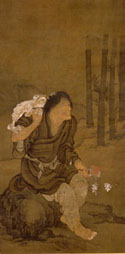Kyoto National Museum
Closes in 11 days
Originally of Taoist origin but happily settled within Japanese Buddhism, "Immortals" are associated with the new year because they represent longevity, prosperity and resolutions. Kyoto National Museum's auspicious exhibition, "The World of Immortals," presents 30 works that stretch back 500 years into Japan's past and 1,000 years into that of China.
Immortals, who were initially human, bridged the human and divine worlds through amazing acts or great piety. Lu Dongbin, who is purported to have lived during the Tang Period (618-907), is said to have wandered in the countryside as a child occasionally meeting such Immortals. When they taught him the tricks of the trade, he himself became one and retreated to the mountains. Lu is customarily represented riding a dragon and holding his elixir of immortality, as Sesson Shukei painted him in the 16th century.
Immortality has its detractors, who humorously represented these beings' bizarre physiognomy and unkempt attire, the result of their hard lives in the wild. But the Immortal Tekkai's unsightly form is of an altogether different kind. After visiting Lao Tzu (the founder of Taoism) in spirit form, he returned seven days later to find his body cremated and had to inherit the corpse of someone who had died of starvation.
This exhibition is an excellent opportunity to trace the painting of Immortals from Yan Hui and Mincho in the 13th and 14th centuries to the Edo Period painters Kano Tanyu and Soga Shohaku.




















With your current subscription plan you can comment on stories. However, before writing your first comment, please create a display name in the Profile section of your subscriber account page.